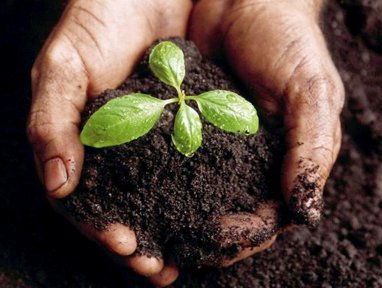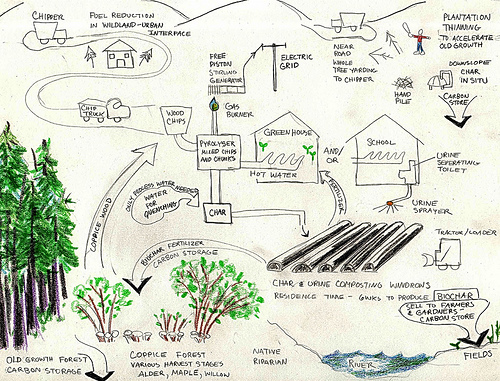Biochar
Uses of biochar
- Inexpensive soil amelioration for degraded land
- Need less land = lower startup costs for a Global Village
- Increased biomass productivity
- Efficient use of biomass waste for energy generation
- Reduced need for fertilizer input (e.g. manure), which is important for the planned Permaculture Plantout at Factor e Farm.
- Combine biochar with vermicompost to make superb fertilizer.
- Pyrolysis gas can be used for energy (i.e. compressed fuel gas) and as a heat source (e.g. for heating greenhouses). As a source of hydrogen, CO and small amounts of methane, pyrolysis gas may be useful for various processes
- Bio-oil and tars are also by-products of pyrolysis, can be turned into biodiesel
- Use Lifetrac to mix char into soil, till
- Add charcoal to compost heap to speed up composting (probably works via enhanced microbial activity)
- Biochar for sale as a source of income for an emerging community.
- Combine with solar thermal heat source to make an open source solar pyrolysis unit
- Charcoal already needed for other purposes, e.g. metal smelting
- Charcoal as filter: can be used for water purification and filtration, later become biochar; can be used to filter pyrolysis gas itself
- Lastly, charcoal can also help neutralize smell in a composting toilet. Then it becomes biochar, ultimately.
Background
Biochar is charcoal made by heating plant matter in an environment that is closed off from air. It absorbs carbon dioxide from the air and keeps it in the soil. Adding biochar to soil increases the soil's capacity to hold nutrient, ultimately resulting in more fertile soil, better plant growth and reduced need for fertilizer.
According to the International Biochar Initiative:
"Char-amended soils have shown 50 - 80 percent reductions in nitrous oxide emissions and reduced runoff of phosphorus into surface waters and leaching of nitrogen into groundwater. As a soil amendment, biochar significantly increases the efficiency of and reduces the need for traditional chemical fertilizers, while greatly enhancing crop yields. Renewable oils and gases co-produced in the pyrolysis process can be used as fuel or fuel feedstocks. Biochar thus offers promise for its soil productivity and climate benefits.
Some of the world's most productive soils (e.g. Canadian prairies, Russian Chernozem / or "black earth") are very rich in organic carbon. This is now thought to be pyrogenic in origin, likely originating from prairie or forest fires. The black carbon is often thousands of years old, demonstrating its stability in soil. For more extensive background on Biochar, please look up the Wikipedia entry
How to make it
Instructable on the retort kiln: http://www.instructables.com/id/How-to-Make-some-Charcoal/
The Biochar Economy
(image from Flickr user visionshare by CC license)
Specifics
When large chunks of wood are used as feedstock, they may need to be crushed before use (beware: coal dust explosion !). Many agrigultural feedstocks and leaf litter will not need to be pulverized.
For information on small-scale gardening, please consult the Gardening with Biochar FAQ, an excellent resource.
Discussion
Could someone suggest a design for a simple flexi-pyrolysis unit that makes both charcoal and SynGas ?
Some discussion of Biochar manufacture and use (including reference to mobile pyrolyser developed at VA Tech) on this blog posting: Turning Points - Biochar: Make It or Buy It?. Two earlier posts on biochar from Turning Points blog.
Links
Wikipedia entry on Biochar [1]
Gardening with Biochar FAQ [2]
BioEnergy Lists: Terra Preta (Biochar) [3]
International Biochar Initiative (IBI) [4]
Biochar Fund [5]
Folke Günther's "the simplest of the simple" two-barrel charcoal retort
Review article on Biochar [6]
Aggregate of biochar design information http://terrapreta.bioenergylists.org/

